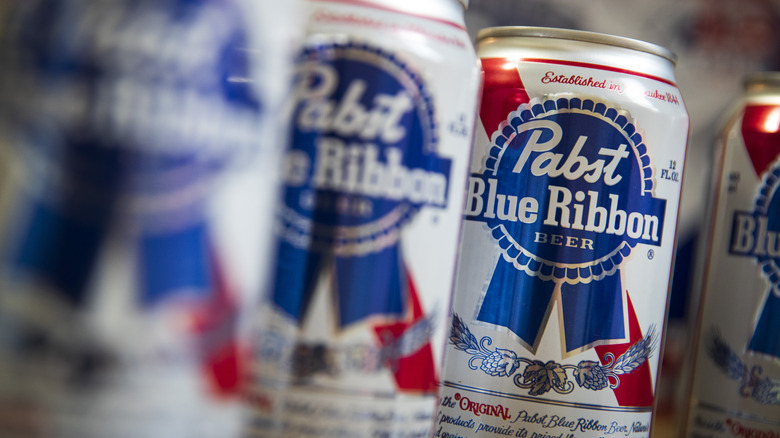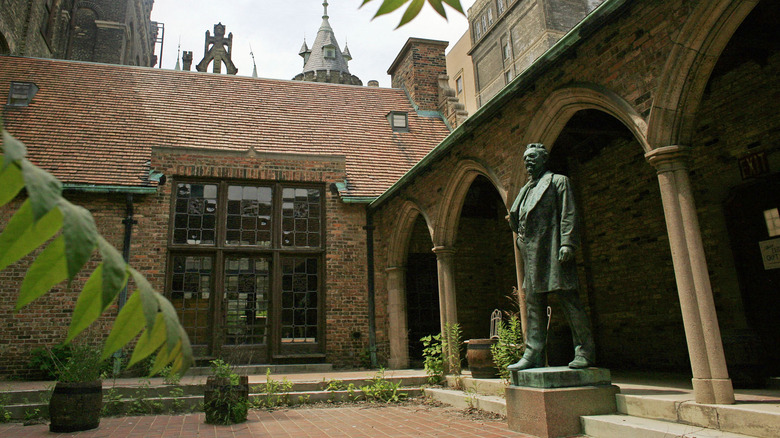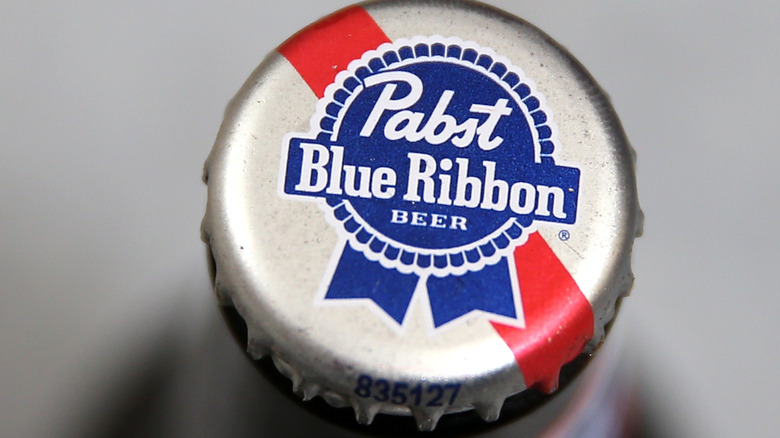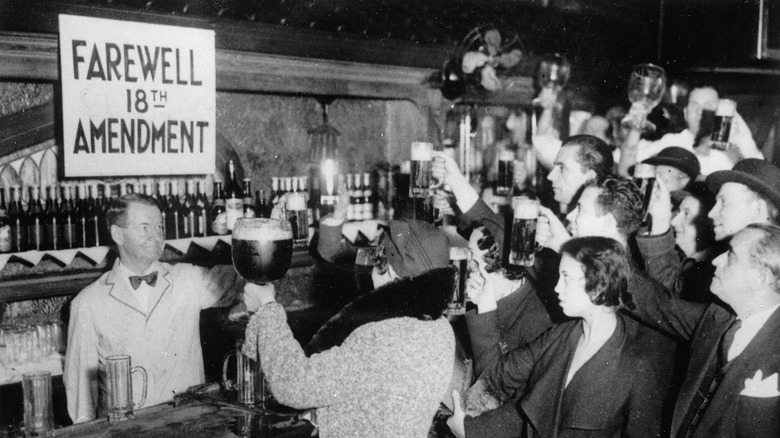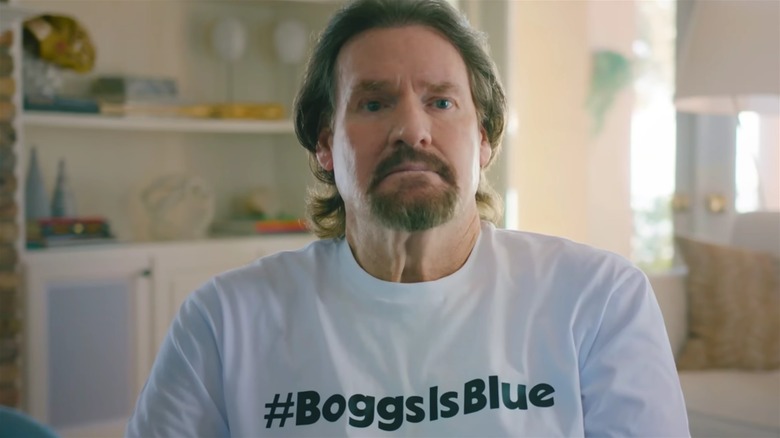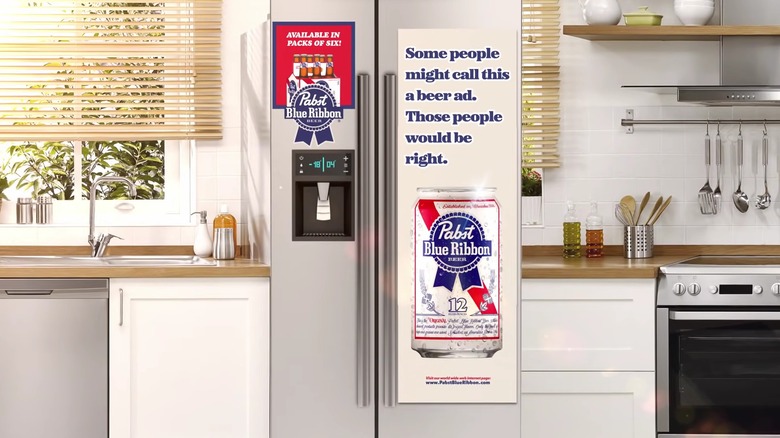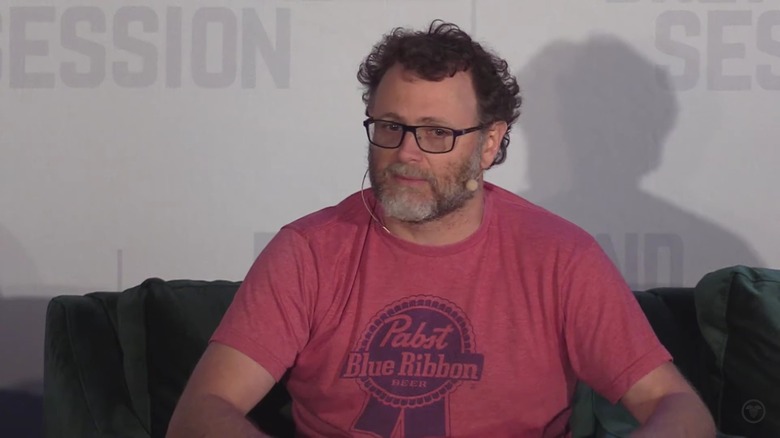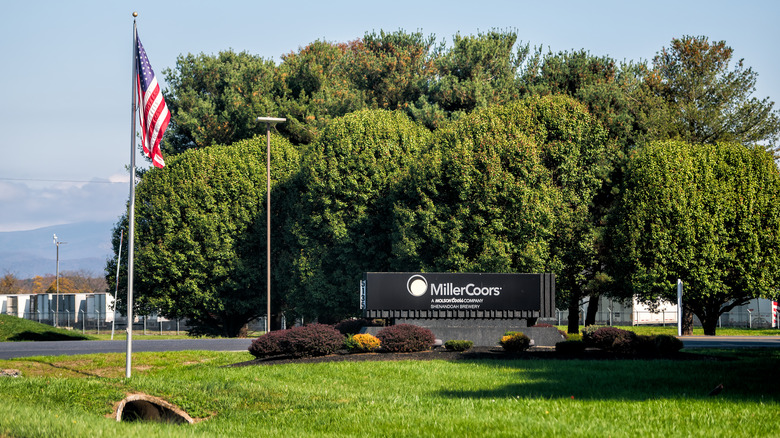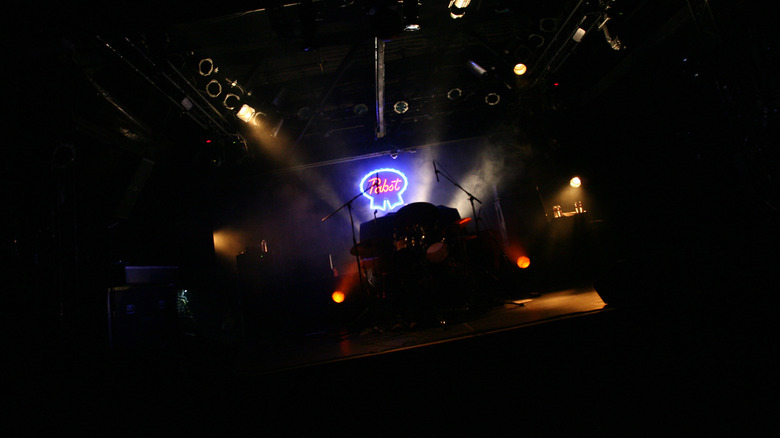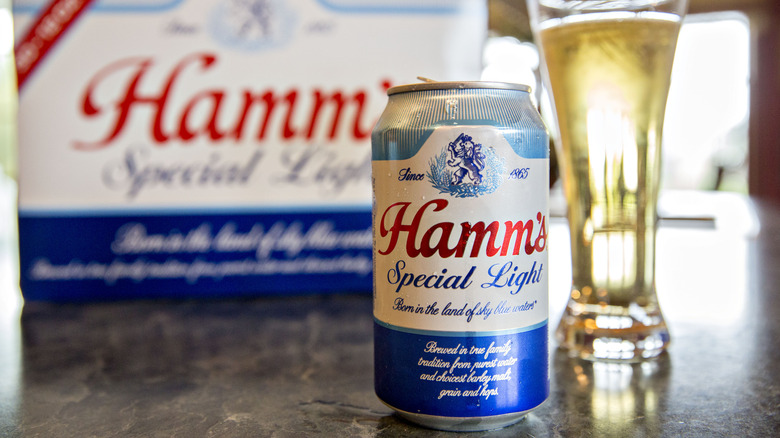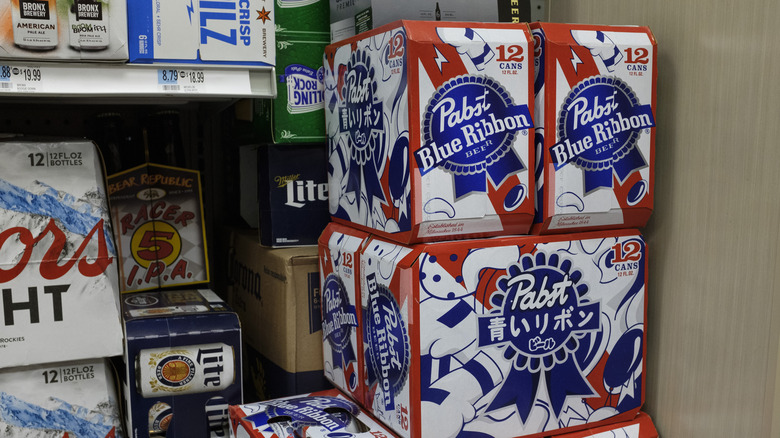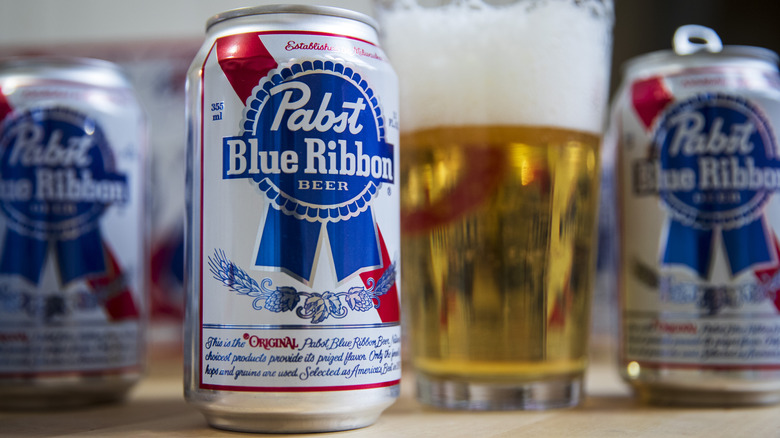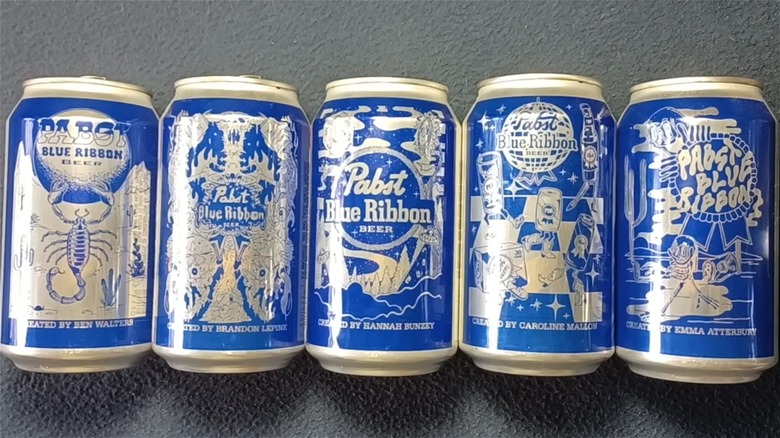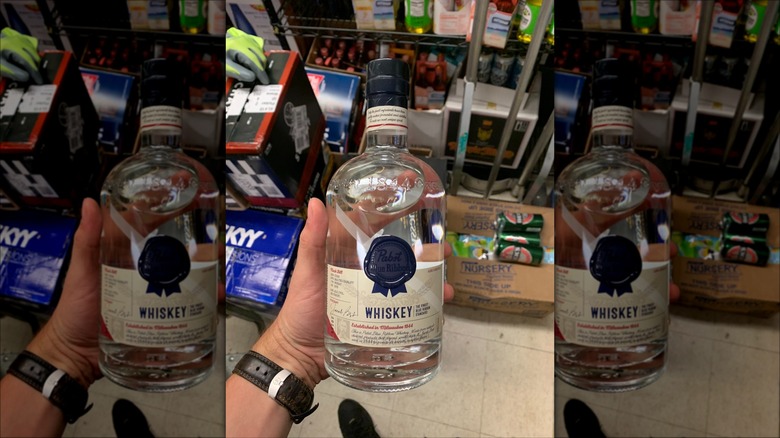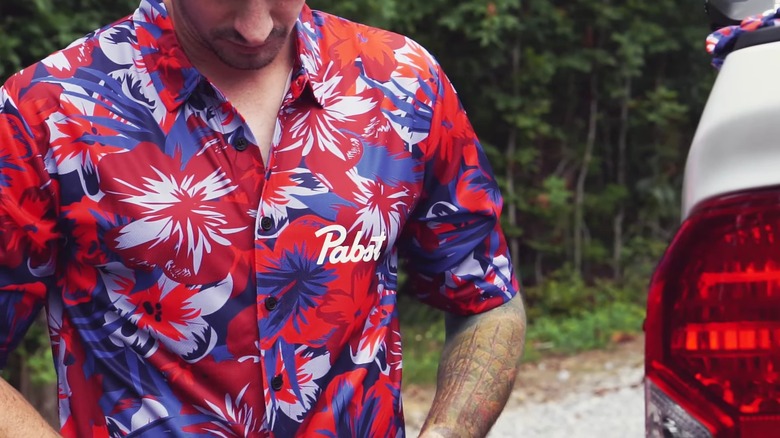Pabst Blue Ribbon: 14 Things You Might Not Know About The Popular Beer Brand
Pabst Blue Ribbon is one of America's quintessential beer brands. Invented and popularized by German immigrants, the beer has become incredibly well known; a 2022 study by Statista found that 72% of Americans were familiar with the brand. YouGov puts the brand's notoriety even higher, stating that 89% of Americans have heard of Pabst Blue Ribbon. While exact percentages are contested, it is undebatable that such familiarity is directly linked to the fame of this eponymous beer. Production numbers back this sentiment up with over 4 million barrels of Pabst Blue Ribbon being brewed every year.
Such impressive numbers suggest that Pabst Blue Ribbon's trajectory has always been upwards. This is not the case; the brand has experienced both meteoric rises and vertiginous crashes throughout its long history. What's more, Pabst Blue Ribbon has not gone about things in the regular manner, choosing alternative means of advertising and operating wherever possible. While key to the beer brand's success, this approach has resulted in Pabst Blue Ribbon boasting more than its fair share of oddities.
1. Pabst beer was first made in 1844
In 1844, Jacob Best Sr. started a brewing business with his four sons. All of them were experienced brewers and had recently moved from Mettenheim, a municipality in the southeast of Germany, to Milwaukee in order to pursue the American dream. Initially, beer production was low, standing at 300 barrels per year.
Of Best Sr.'s four sons, only one, Philip, remained with the business. Upon his father's retirement, Phillip Best took over the company in 1859. Three years later, his sister Maria married another German immigrant by the name of Frederick Pabst. Pabst was a shipping captain at this time but quickly sold his interests after a boat he was captaining was crippled in a storm. Using the money from the sale, Pabst bought half of his brother-in-law's brewery for just over $21,000. Along with another brother-in-law, Emil Schandein, Pabst worked furiously to improve the business and soon took over from the ailing Phillip Best. The results of this takeover were dramatic; by 1872, production had leapt to 100,000 barrels per year.
Pabst was a firm believer in growth and oversaw the brewery's national expansion, opening 40 offices between 1879 and 1893. During this time, Schadein passed away, leaving Pabst as the sole owner of the business, which he promptly renamed Pabst Brewing Company.
2. 'Blue Ribbon' was only added to the name in 1895
Contrary to common belief, Pabst had been decorating his beer bottles with blue ribbons from as early as 1882. However, the blue ribbon became synonymous with the brand after The Chicago World's Fair, held in 1893. During the six months it was open, this fair attracted 27 million visitors who witnessed marvels including the first Ferris wheel. Pabst Brewing Company was also present at the fair.
Beers were judged on a scale of 0 to 100 on factors including color and flavor. Beers were not judged against one another. Instead, any brewer that received an overall score of 80% was awarded a certificate of excellence and a bronze medal. According to the Digital Research Library of Illinois History Journal, this did not stop Pabst from proclaiming his beer as the outright winner of the fair in an astounding marketing ploy.
So successful was this ploy that Pabst and blue ribbons became synonymous. In 1895, the company added 'Blue Ribbon' to the beer's name. Four years later, the company changed it completely to Pabst Blue Ribbon. The effect was enormous; sales leapt to 100 million barrels annually and by the early 1900s, the business was using more than 1 million feet of blue silk ribbon per year to decorate its bottles.
3. During Prohibition, Pabst made cheese
In the run-up to Prohibition, many breweries, Pabst included, developed so-called near beers which had less than 0.5% alcohol by volume as well as non-alcoholic alternatives. These products were designed to replace products like Pabst Blue Ribbon should alcohol be banned. However, they did not prove popular during Prohibition largely because bootlegged beer was so easy to come by.
Despite investing in developing its own non-alcoholic drink, Pabst was well-placed to weather Prohibition. This was because the company was rich in both cash and assets, especially real estate as author Maureen Ogle highlighted to History: "What separated the companies that made it from the ones that didn't is what they had to begin with at the start of Prohibition. The Pabst, Busch and Miller families had all invested in real estate holdings across the United States." By 1910, Pabst owned property in 187 cities. During Prohibition, these properties were leased, rented, or sold, providing the company with a key source of income.
Pabst also survived thanks to its investments in farmland. These purchases had initially been to rear horses but cows soon replaced them. As a result, Pabst had a ready source of milk when Prohibition struck. With this milk, Pabst created Pabst-ett, a spreadable processed cheese. Around 8 million pounds of Pabst-ett was sold during Prohibition and the cheese brand was eventually sold to Kraft.
4. Pabst has worked with many famous people
For decades, Pabst has hired celebrities to endorse its products, especially its most famous beer. During the mid-20th century suave actors like Gregory Peck and Bob Hope were used in advertisements for Pabst Blue Ribbon. Aside from those working on the screen, the brand also sought out athletes, including those from a wide range of sports. In the '50s, this included baseball legend Tommy Henrich; 20 years later, bodybuilder Frank Zane starred in his own Pabst Blue Ribbon commercial.
Today, Pabst Blue Ribbon still relies on athletes to endorse its beer. In 2023, it was announced that Hall of Famer third baseman Wade Boggs was signing with the company. This was the result of an extended ad campaign that became known as #BoggsIsBlue. During the tongue-in-cheek campaign Boggs said to PRNewswire: "Pabst Blue Ribbon owes me, and fans across the nation, the truth, Boggs is Blue. I'm after justice, and nothing tastes better with it than an ice cold PBR."
5. Pabst Blue Ribbon has run some wacky marketing schemes
As the #BoggsIsBlue campaign highlights, Pabst Blue Ribbon has a penchant for wacky marketing schemes. This practice of creating advertising campaigns that bucked the norm began in the early 2000s when Pabst Blue Ribbon was struggling. In 2001, the brand posted sales of under 1 million barrels, however, reps for the brand began to notice that an alternative crowd was adopting the beer, largely because the brand eschewed traditional marketing. During 2002, for example, Pabst spent less than $450,000 on media advertisements.
Pabst Blue Ribbon soon began to target the young, alternative demographic that was adopting the brand by sponsoring community-led events such as skateboard movie screenings, bike polo tournaments, and art gallery events. Soon, the brand became associated with the hipster community for reasons Dr. Margaret Campbell, who co-authored a study on the relationship between autonomy and perceived coolness, explained to Outside: "Hipsters are on the countercultural end of that spectrum. We showed that the point at which something is perceived as cool is more autonomous for people who are higher in counterculturalism than people who are lower in counterculturalism." Overtime, this led the brand to gain mainstream popularity.
Now with a large consumer base, Pabst Blue Ribbon has invested in increasingly ambitious advertising campaigns that reinforce the brand's slightly leftfield image. Recent examples, aside from the #BoggsIsBlue campaign, include an advertisement campaign where Pabst pays people to put up company advertisements in their own home.
6. Pabst Brewing Company is owned by Blue Ribbon Partners
Pabst Blue Ribbon, along with several other beer brands, is owned by Pabst Brewing Company. This company has changed hands numerous times during the 21st century alone. C. Dean Metropoulos, a Greek-American billionaire, bought the company in 2010 for $250 million. Metropoulos sold Pabst Brewing Company four years later to a group of investors led by Eugene Kashper, a prominent beer entrepreneur, and a private equity firm called TSG Consumer Partners.
At the time of the purchase Kashper said to TSG Consumer Partners: "The opportunity to work with a timeless American brand like Pabst Blue Ribbon is a dream come true. We will stay true to Pabst's roots and are committed to investing in the Company's organization and brands."
During 2021, it was announced that TSG Consumer Partners had divested its stake in the company and that Pabst Brewing Company was now 100% owned by Blue Ribbon Partners, an investment platform chaired by Kashper.
7. Today, Pabst outsources all brewing
At the time of writing, Pabst Brewing Company outsources all of the production for Pabst Blue Ribbon. In fact, the beer has been made by MillerCoors from as early as 1999. For many years, the agreement between Pabst and MillerCoors ran smoothly with the latter company making between $70 million and $80 million annually from the agreement. However, a lawsuit arose when the two companies began contesting how the agreement, which was slated to end in 2020, should be extended. The lawsuit was settled in the fall of 2018.
One year later, it was announced that Pabst Brewing Company was moving the majority of its production to City Brewing. From 2024 onwards, most Pabst beers will be brewed on City Brewing premises. This agreement is scheduled to last until 2040. In a press release via Brewbound, Eugene Kashper said: "We are thrilled to establish this long-term partnership with City Brewing. We have great respect for George Parke and his family, and also for the management team's operational excellence, and the entire organization's commitment to quality."
8. The beer regained popularity in the early 2000s
Pabst Blue Ribbon struggled mightily during the late 80s, 90s, and early 00s as its core audience aged. In order to regain some popularity, the brand had to find a new audience and it did so in Portland during 2001 and 2002. Here, sales were doubling while Pabst sales across the country continued to fall. As we've seen, Pabst quickly discovered that hipsters had adopted the brand and worked to align themselves with this new demographic.
While marketing ploys, such as sponsoring events, played a large role in the brand's growing relevance in these markets, the day-to-day work of field marketing reps also played a huge part in the brand's success as Steve Nilsen, former Lifestyle Marketing Manager at Pabst explained to The Challenger Project: "What big corporations fail to realise is it's a tonne of travel and work building relationships. Big beer companies would dump product at a skate shop and 'check the box'. You've got to go in and hang out with them, watch a film, take care of them."
The demise of hipster culture led many media brands to predict the death of Pabst Blue Ribbon. By all accounts, however, the brand is still alive and kicking.
9. Pabst vs Hamm's
Theodore Hamm was a German immigrant who came to America and brewed beer, much like Jacob Best Sr. The similarities between Pabst Blue Ribbon and Hamm's do not end there. Both beers are light in nature and relatively bland. The two beers also have a history of being brewed by MillerCoors.
These similarities have led some people to confuse the two brands or, in some circumstances, to believe the brands are selling the same beer. This theory is backed up by the beers' appearances; both are pale yellow in color and boast a small foam head upon pouring.
That being said, the two are actually distinct from one another. This becomes clear when tasted side by side. Many beer enthusiasts state that the flavor of Hamm's tends to be on the slightly sweet side while Pabst Blue Ribbon leans bitter. In other words, the two beers are both lagers with a similar company history, but they are not the same thing.
10. Its cheap price has long been a selling point
Throughout its recent history, Pabst Blue Ribbon has been known as a cheap beer. This is not a bad thing. In fact, the brand's extremely low price was one of the main reasons why Portland's taverns, clubs, and pubs started selling it in the early 2000's, as Layne Martin, who was manager at Portland's Lutz Tavern explained to Willamette Weekly: "There was this absolute scorching deal on cases of PBR and kegs. We were one of the few outlets in Portland that sold kegs to go, so we could sell them at a really good deal. So we started the PBR dollar-can special [...] We were going through hundreds of cases and dozens of kegs a week."
Martin could afford to sell Pabst Blue Ribbon so cheap because the brand sold its products at incredibly low prices. Cans cost the tavern 35 cents. Many individuals who played a role in popularizing Pabst, first in Portland and further afield, highlighted that this low price tag was a huge reason they adopted and stuck with the brand.
Unfortunately, the beer's prices have not remained this low. In 2013, it was reported that the sub-premium beer market, led by Pabst Blue Ribbon, was seeing considerable price increases. This was due to increased demand and minimal competition. Over the years, this has led to the prices of sub-premium beers becoming permanently inflated. Today, Lutz Tavern sells cans of Pabst Blue Ribbon for $4.
11. PBR's nutritional information
A single, 16-ounce can of Pabst Blue Ribbon contains 204 calories, 16.9 grams of carbohydrate, and 2.2 grams of protein. These values are similar to many other light lagers sold in the United States including Budweiser. Some even lighter beers, such as Bud Light, contain significantly fewer calories, protein, and carbohydrates.
The reason why beers like Pabst Blue Ribbon are relatively low in calories is simple: They are quite low in alcohol. According to the NHS, alcohol contains 7 calories per gram. This means that stronger beers, like Big Sky Brewing's Ivan The Terrible Imperial Stout, contain much more calories. In fact, this 13.9% ABV beer contains over 450 calories per 16-ounce serving.
In general, craft beers tend to be stronger, meaning they often contain more calories than light, mainstream lagers such as Pabst Blue Ribbon which has an ABV of 4.7%. That being said, a paper published in Current Research in Food Science revealed that craft beers are often higher in healthy, phenolic compounds. This suggests that craft beers are in fact healthier, calories notwithstanding.
12. The company holds art contests
Pabst Blue Ribbon has become increasingly involved in the arts during the past decade. In 2014, it launched Project Pabst, a musical festival that ran until 2017 and featured artists including Nas and Iggy Pop. During the Coronavirus pandemic, the brand commissioned 1,000 creatives from various fields to create Pabst-related work. These included drinks recipes from bartenders as well as visual designs from illustrators.
The most enduring example of Pabst Blue Ribbon's dedication to the arts is its annual Art Can Contest. Also launched in 2014, this contest sees thousands of artists submit designs for the chance for their illustration to be printed on Pabst Blue Ribbon cans that are sold around the country. Ten winners are selected, receiving a $10,000 prize to boot. As Andrew Heard, Pabst Blue Ribbon's brand manager of art highlighted to Packaging Digest its not just artists that benefit: "The Art Can Contest allows us to literally turn our biggest platform into a blank canvas for an emerging artist. We put original art in the hands of millions every year and allow our customers to experience incredible art wherever they are enjoying a Pabst Blue Ribbon."
It appears that Pabst Blue Ribbon did not run the Art Can Contest during 2023. However, Pabst Canada is running a 2024 competition.
13. The brand has released other beverages
While Pabst is most famous for Pabst Blue Ribbon, the company has released a variety of other beverages including Pabst Blue Ribbon Extra, a stronger version of the lager and Pabst Blue Ribbon Easy, a low calorie variation. The company has also dabbled in more adventurous releases as exemplified by the whiskey it released to mark Pabst's 175th anniversary.
This limited edition beverage paid homage to Pabst's founder Jacob Best by being made with local, Midwestern ingredients and being almost completely unaged. In an interview with Esquire, former general manager of Pabst Matt Bruhn described the whiskey: "You can shoot it — it's got some kick to it, obviously, because it's un-aged. But it's also really good in a mixed drink. Like it makes a killer Old Fashioned, because the strength cuts really well through the sugar."
The company also created a hard coffee product that was available between 2019 and 2022 and was the market leader. However, Pabst has since turned its attention towards other products including a range of cannabis-infused seltzers. These are produced and sold through a company called Pabst Labs and each of the six flavors is infused with 10 milligrams of THC.
14. The company frequently collaborates with other brands
As is so often the case nowadays, Pabst Blue Ribbon has sought to boost its profile by collaborating with several other brands on a range of products. Collaborations have been made with various clothing brands including PLEASURES, who produced a Pabst Blue Ribbon capsule that contained beanies and T-shirts. Elsewhere in clothing, Pabst Blue Ribbon has teamed up with menswear brand One of These Days. This 2023 release saw trucker caps and T-shirts released alongside other products including a Pabst Blue Ribbon lighter and pint glass.
The year 2023 also saw Pabst Blue Ribbon collaborate with Handup Gloves to produce a range of gear designed for cycling enthusiasts. This release revolved around Handup Gloves' iconic product: printed, specialist mountain biking gloves, although other products were available including socks, shirts, and bicycle mudguards. The huge range of collaborations released during 2023 highlights how vital collaborations have become to Pabst Blue Ribbon's business model. We expect many more collaborations to be released in the coming years.
